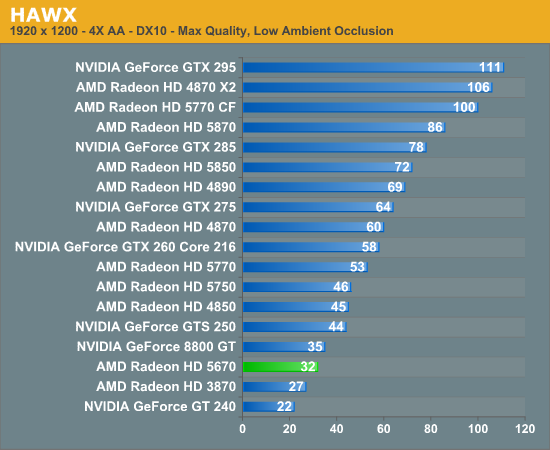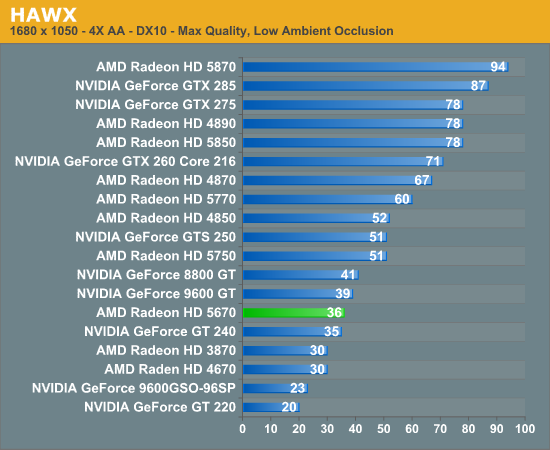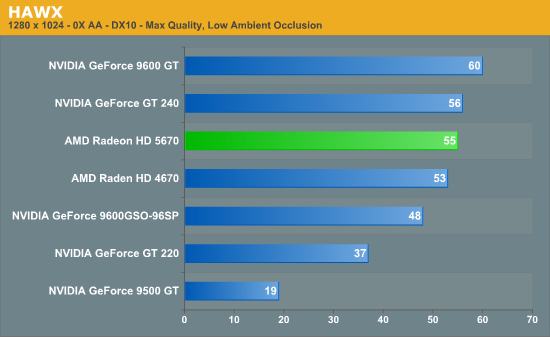AMD's Radeon HD 5670: Sub-$100 DirectX 11 Starts Today
by Ryan Smith on January 14, 2010 12:00 AM EST- Posted in
- GPUs
HAWX
HAWX is another game that’s not particularly GPU-bound, which means we can turn in some high numbers.



HAWX gives us some interesting results, particularly when compared to the GT 240. At very high resolutions the 5670 is well ahead of the GT 240, pushing out a 45% lead at 1920 and still maintaining a playable 32fps frame rate. On the other hand at 1280, the GT 240 comes ahead by a frame. This is fairly consistent with earlier data, and it looks like the 5670 can really pull away from NVIDIA’s newer cards at higher resolutions.
Compared to the 8800 GT and 4850, the 8800 GT maintains a comfortable lead, and the 4850 is consistently in another class altogether. Meanwhile the 4670 is fairly close here, which makes sense given that the 5670’s shader advantage is less beneficial here.










73 Comments
View All Comments
JarredWalton - Sunday, January 17, 2010 - link
As far as CPU multiplier, if you have the i7-720QM the normal multiplier is 12X (133 bus * 12 = 1.6GHz). For the i7-820QM the stock multiplier is 13 (1.73GHz). Maximum Turbo mode on the 720QM is 2.80GHz, so you could potentially see a 21X multiplier, while on the 820QM the maximum Turbo is 3.066GHz so you'd see up to a 23X multiplier. I don't know if throttle stop tells you max and min multipliers or not, but you could even run CPU-Z and just watch to see if the multiplier is changing a lot.SlyNine - Tuesday, January 19, 2010 - link
Yea I have been watching a few programs including throttle stop, Realtemp and Realtemp GT, including I7 turbo. They all show the max multiplier at 7-9 when gaming under load, even with an external monitor hooked up and this screen off it doesn't go past 10. Its worth noting that with the screen brightness turned down and CPU load only they stay at 12, but turn the brightness up and your multi falls to 8.The biggest problem is the clock modulation, which I'm trying to test. But it definitely correlates with real world performance, while task manager may show the CPU at 100%, throttle stop reports a 75% reduction in CPU usage. This also correlates with the delta that taskmanager indicates CPU usage at and what programs like I7turbo and real temp show the C0 state percent. Task manager will show 100% while the C0% will be at 25%, indicating a 75% reduction while under load.
Perhaps throttle stop just measures the difference between the CO% and what the OS reports.
I've custom set all the settings in the advanced power options to be the same on and off battery. When you unplug the system runs a great deal faster, albeit at the risk of harming the battery. I've disabled speed step as well with no difference.
Excel isn't my strong suit(basically I'm going to have to relearn how to use it) but I'm trying to correlate frame rate with the indicated clock modulation. But I'm unsure how to record a timeline of FPS. It does appear though that the FPS do report accurately when the clock modulation kicks in.
satish2685 - Monday, April 1, 2013 - link
Hi, I would like to purchase an Entry level 1GB DDR3 Asus Geforce HD5450 Graphics Card, but considering the power requirements, i only have an 250W PSU. Is it ok to buy a graphic card that requires a minimum of 400w and connect it to my existing MB or do i need to upgrade my PSU?? Advice required. If so any consequences i could face in future ??